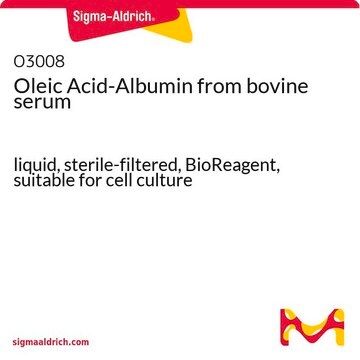Unfortunately, the stability of this product in solution is not determined.
P5585
Palmitic acid
BioXtra, ≥99%
Synonym(s):
1-Pentadecanecarboxylic acid, C16:0, Cetylic acid, Hexadecanoic acid, NSC 5030, PamOH
Select a Size
Select a Size
About This Item
Recommended Products
biological source
plant (vegetable)
Quality Level
vapor pressure
10 mmHg ( 210 °C)
product line
BioXtra
Assay
≥99%
form
powder
technique(s)
cell culture | mammalian: suitable
impurities
≤0.0005% Phosphorus (P)
≤0.1% Insoluble matter
ign. residue
≤0.1%
bp
271.5 °C/100 mmHg (lit.)
mp
61-62.5 °C (lit.)
solubility
chloroform: 0.5 M, clear, colorless
density
0.852 g/mL at 25 °C (lit.)
anion traces
chloride (Cl-): ≤0.05%
sulfate (SO42-): ≤0.05%
cation traces
Al: ≤0.005%
Ca: ≤0.0005%
Cu: ≤0.0005%
Fe: ≤0.0005%
K: ≤0.005%
Mg: ≤0.0005%
NH4+: ≤0.05%
Na: ≤0.05%
Pb: ≤0.001%
Zn: ≤0.0005%
functional group
carboxylic acid
lipid type
saturated FAs
shipped in
ambient
storage temp.
room temp
SMILES string
CCCCCCCCCCCCCCCC(O)=O
InChI
1S/C16H32O2/c1-2-3-4-5-6-7-8-9-10-11-12-13-14-15-16(17)18/h2-15H2,1H3,(H,17,18)
InChI key
IPCSVZSSVZVIGE-UHFFFAOYSA-N
Gene Information
human ... FABP2(2169) , FABP3(2170) , FABP4(2167) , FABP5(2171)
Looking for similar products? Visit Product Comparison Guide
Application
Biochem/physiol Actions
Storage Class Code
11 - Combustible Solids
WGK
nwg
Flash Point(F)
235.4 °F
Flash Point(C)
113 °C
Personal Protective Equipment
Choose from one of the most recent versions:
Certificates of Analysis (COA)
Don't see the Right Version?
If you require a particular version, you can look up a specific certificate by the Lot or Batch number.
Already Own This Product?
Find documentation for the products that you have recently purchased in the Document Library.
Customers Also Viewed
Articles
Lipid Induced Insulin Resistance
Fatty acid synthesis supports cancer cell proliferation, essential for membrane generation, protein modification, and bioenergetics.
-
I want to know the storage temperature after reconstituting the product in the solvent? Also clarify regarding the type of solvent to be used?
1 answer-
Helpful?
-
-
How can I determine the shelf life / expiration / retest date of this product?
1 answer-
If this product has an expiration or retest date, it will be shown on the Certificate of Analysis (COA, CofA). If there is no retest or expiration date listed on the product's COA, we do not have suitable stability data to determine a shelf life. For these products, the only date on the COA will be the release date; a retest, expiration, or use-by-date will not be displayed.
For all products, we recommend handling per defined conditions as printed in our product literature and website product descriptions. We recommend that products should be routinely inspected by customers to ensure they perform as expected.
For products without retest or expiration dates, our standard warranty of 1 year from the date of shipment is applicable.
For more information, please refer to the Product Dating Information document: https://www.sigmaaldrich.com/deepweb/assets/sigmaaldrich/marketing/global/documents/449/386/product-dating-information-mk.pdfHelpful?
-
-
How is shipping temperature determined? And how is it related to the product storage temperature?
1 answer-
Products may be shipped at a different temperature than the recommended long-term storage temperature. If the product quality is sensitive to short-term exposure to conditions other than the recommended long-term storage, it will be shipped on wet or dry-ice. If the product quality is NOT affected by short-term exposure to conditions other than the recommended long-term storage, it will be shipped at ambient temperature. As shipping routes are configured for minimum transit times, shipping at ambient temperature helps control shipping costs for our customers. For more information, please refer to the Storage and Transport Conditions document: https://www.sigmaaldrich.com/deepweb/assets/sigmaaldrich/marketing/global/documents/316/622/storage-transport-conditions-mk.pdf
Helpful?
-
-
I am curious about the storage temperature of this product.
1 answer-
As listed in the PROPERTIES section of the product page, this product may be stored at room temperature.
Helpful?
-
-
Can you tell me the storage temperature for this product?
1 answer-
As stated in the PROPERTIES section of the product page, this product is stored at room temperature.
Helpful?
-
-
Is this product soluble only in chloroform? Did you know something about its solubility in ethanol or DMSO?
1 answer-
Stock solutions of palmitic acid can be prepared in 200 proof ethanol or DMSO at 20 mg/mL. Stock solutions should be purged with inert gas, such as argon or nitrogen, prior to storage.
Helpful?
-
Active Filters
Our team of scientists has experience in all areas of research including Life Science, Material Science, Chemical Synthesis, Chromatography, Analytical and many others.
Contact Technical Service





